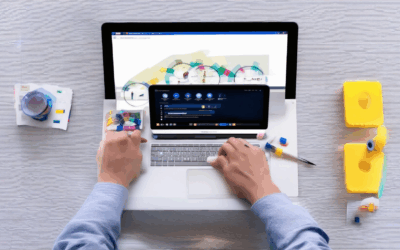In today’s fast-paced digital world, the majority of users rely heavily on mobile devices to access information, shop, and engage with services. As a result, ensuring your website is mobile-optimized has become more than just a trend—it’s a necessity for staying competitive and relevant. Mobile-optimized web design isn’t just about making your site look good on smaller screens; it’s about creating a seamless and intuitive user experience that caters to the unique behaviors and expectations of mobile users. From responsive layouts to typography and navigation, every aspect of your web design plays a crucial role in delivering a frictionless experience. In this comprehensive guide, we’ll delve into the best practices, key elements, and real-world examples that will empower you to master mobile-optimized web design, ensuring your brand stands out in the crowded mobile landscape.
Key Takeaways
– Responsive Design: Ensures seamless adaptation to various screen sizes, leveraging flexible layouts and media queries for optimal display across devices.
– Touch-Friendly Interfaces: Features large, well-spaced buttons, icons, and links for effortless interaction on mobile devices.
– Fast Loading Speeds: Optimizes images and reduces unnecessary code to ensure quick load times, crucial for mobile user patience.
– Intuitive Navigation: Provides clear, user-friendly menus and links, guiding users effortlessly through the site.
– Visual Hierarchy and Spacing: Prioritizes content with typography and spacing, ensuring essential information stands out on smaller screens.
– Performance Optimization: Implements techniques like lazy loading and code minification to enhance speed and reduce battery usage.
– Cross-Device Compatibility: Designs work seamlessly across different manufacturers and operating systems, accommodating varying screen resolutions and hardware.
– Minimalistic Design Approach: Uses clean layouts and simple color schemes to avoid overwhelming users with excessive information.
– Adaptive Images: Delivers images in different resolutions tailored to the specific device, balancing quality and loading efficiency.
– Interactive Elements Optimization: Designs forms, buttons, and dropdowns to be easily clickable and readable on small screens, minimizing accidental taps.
These elements collectively ensure a seamless and engaging user experience across all devices, driving higher engagement and conversion rates.

What is Mobile-Optimized Web Design?
Mobile-optimized web design refers to creating websites and web applications that deliver an excellent user experience across all device types, particularly focusing on mobile devices. This approach ensures seamless functionality, visual appeal, and usability whether users access your site via smartphones, tablets, or desktop computers.
Key Components of Mobile-Optimized Web Design
- Responsive Design: Ensures your website adapts to different screen sizes and devices. This is achieved through flexible layouts, fluid images, and media queries that adjust content based on the screen dimensions.
- Cross-Device Compatibility: Your site must work consistently across various platforms, including iOS and Android devices, as well as older models. This involves testing on multiple devices to ensure compatibility.
- Touch-Optimized Interfaces: Designing buttons, links, and interactive elements to be easily navigable and accessible on touchscreens. Larger touch targets and intuitive navigation patterns are essential for mobile users.
- Fast Loading Times: Mobile users have limited patience for slow-loading sites. Optimizing images, leveraging browser caching, and minimizing code ensures quick load times.
- Readable Text and Buttons: Ensuring text is legible on smaller screens and buttons are easy to tap. Proper spacing and font choices are critical for usability.
Why Mobile Optimization Matters
With more than half of global internet traffic originating from mobile devices, optimizing for mobile is no longer optional. Mobile-optimized web design improves user engagement, reduces bounce rates, and can significantly boost your site’s ranking in search engine results pages (SERPs).
Getting Started with Mobile Optimization
To implement mobile-optimized web design, consider the following steps:
- Use a Mobile-Friendly Content Management System (CMS): Many CMS platforms offer mobile-optimized themes and templates that simplify the process.
- Test on Multiple Devices: Regularly test your website on various mobile devices to identify and fix any compatibility issues.
- Leverage Tools and Frameworks: Utilize tools like Google’s Mobile-Friendly Test or frameworks like Bootstrap and Foundation to streamline the design process.
- Optimize Images and Videos: Compress images and use video formats that are compatible with mobile devices to reduce bandwidth usage.
Resources for Further Learning
For more insights into mobile-optimized web design, explore resources like 119WebDesign’s Mobile Website Design Guide and other reputable sources. By adopting these best practices, you can create a website that truly excels on all devices.
Best Practices for Creating a Mobile-Optimized Web Design
Creating a mobile-optimized web design is essential for ensuring your site provides a seamless and user-friendly experience across all devices. Here are some proven strategies to achieve this:
- Mobile-First Approach : Start by designing for mobile devices and then scale up to larger screens. This ensures your layout is intuitive and functional on smaller screens first.
- Responsive Design Techniques : Use flexible layouts and media queries to adapt to different screen sizes. This allows your site to automatically adjust to various devices without manual adjustments.
- Image Optimization : Optimize images by compressing them, converting to webp format, and using lazy loading to reduce page load times and improve performance on mobile devices.
- Typography Considerations : Choose fonts that are scalable and legible on smaller screens. Adjust font sizes and line heights to ensure text remains readable and visually appealing on mobile.
- Simplified Navigation : Use a hamburger menu or collapsible navigation for mobile views. Ensure links are easy to tap and avoid unnecessary interactions that could disrupt the user experience.
- Viewport Settings : Include a viewport meta tag in your HTML to control how the page scales on mobile devices. Add properties like
viewport-fit: preventto prevent users from zooming in. - Performance Optimization : Minimize HTTP requests by combining CSS and JavaScript files, leveraging browser caching, and implementing progressive web apps to enhance loading speeds.
- Cross-Browser Compatibility : Test your design across various mobile browsers and devices to ensure compatibility and functionality. Address any issues immediately to provide a consistent experience.
- Touch-Friendly Interfaces : Design buttons and interactive elements with sufficient size and spacing to make them easily accessible on touchscreens. Provide visual feedback for user interactions.
- Regular Testing : Continuously test your design on different devices and screen sizes. Use tools like device emulators and screen readers to ensure accessibility and usability across all platforms.
- Continuous Monitoring : Keep an eye on your site’s performance metrics and user feedback to identify areas for improvement. Update your design and functionality regularly to stay ahead of technological advancements.
By following these best practices, you can create a web design that not only looks great on mobile devices but also enhances user engagement and overall performance.

Best Practices for Creating a Mobile-Optimized Web Design
Creating a mobile-optimized web design is essential for ensuring your site provides a seamless and user-friendly experience across all devices. Here are some proven strategies to achieve this:
- Mobile-First Approach : Start by designing for mobile devices and then scale up to larger screens. This ensures your layout is intuitive and functional on smaller screens first.
- Responsive Design Techniques : Use flexible layouts and media queries to adapt to different screen sizes. This allows your site to automatically adjust to various devices without manual adjustments.
- Image Optimization : Optimize images by compressing them, converting to webp format, and using lazy loading to reduce page load times and improve performance on mobile devices.
- Typography Considerations : Choose fonts that are scalable and legible on smaller screens. Adjust font sizes and line heights to ensure text remains readable and visually appealing on mobile.
- Simplified Navigation : Use a hamburger menu or collapsible navigation for mobile views. Ensure links are easy to tap and avoid unnecessary interactions that could disrupt the user experience.
- Viewport Settings : Include a viewport meta tag in your HTML to control how the page scales on mobile devices. Add properties like
viewport-fit: preventto prevent users from zooming in. - Performance Optimization : Minimize HTTP requests by combining CSS and JavaScript files, leveraging browser caching, and implementing progressive web apps to enhance loading speeds.
- Cross-Browser Compatibility : Test your design across various mobile browsers and devices to ensure compatibility and functionality. Address any issues immediately to provide a consistent experience.
- Touch-Friendly Interfaces : Design buttons and interactive elements with sufficient size and spacing to make them easily accessible on touchscreens. Provide visual feedback for user interactions.
- Regular Testing : Continuously test your design on different devices and screen sizes. Use tools like device emulators and screen readers to ensure accessibility and usability across all platforms.
- Continuous Monitoring : Keep an eye on your site’s performance metrics and user feedback to identify areas for improvement. Update your design and functionality regularly to stay ahead of technological advancements.
By following these best practices, you can create a web design that not only looks great on mobile devices but also enhances user engagement and overall performance.

Key Elements of a Mobile-Optimized Web Design
A mobile-optimized web design ensures seamless browsing experiences across devices, improving user engagement and conversion rates. Here are the essential components:
- Responsive Design:** Ensures websites adapt to various screen sizes, providing a consistent layout on desktops, tablets, and smartphones. This is achieved through flexible layouts and media queries.
- Touch-Friendly Interface:** Design elements like buttons, icons, and links should be large enough and spaced well to facilitate easy interaction with fingers.
- Fast Loading Speeds:** Optimize images, reduce unnecessary code, and leverage browser caching to ensure quick load times, which is critical for mobile users with limited patience.
- Intuitive Navigation:** Simplify navigation with clear labels, visible links, and a logical hierarchy to guide users effortlessly through the site.
- Visual Hierarchy and Spacing:** Prioritize content with typography and visual cues, ensuring essential information stands out while preventing clutter on smaller screens.
- Performance Optimization:** Implement techniques like lazy loading for images and code minification to enhance speed and reduce battery usage on mobile devices.
- Cross-Device Compatibility:** Ensure designs work seamlessly across different manufacturers and operating systems, accounting for variations in screen resolutions and hardware capabilities.
- Minimalistic Design Approach:** Use clean layouts, simple color schemes, and avoid overwhelming users with excessive information or complex interactions.
- Adaptive Images:** Serve images in different resolutions based on the device, ensuring high-quality visuals without compromising loading times.
- Interactive Elements Optimization:** Design forms, buttons, and dropdowns to be easily clickable and readable on small screens, reducing the risk of accidental taps or misinterpretation.
By focusing on these elements, businesses can deliver a seamless and engaging user experience across all devices, driving higher engagement and conversion rates.
Learn more about our web design services to optimize your mobile experience further.
How Does Mobile-Optimized Web Design Improve User Experience?
Mobile-optimized web design significantly enhances user experience by addressing the unique challenges and opportunities presented by mobile devices. Here’s a breakdown of the key benefits:
- Seamless Navigation: Mobile-optimized designs feature intuitive menus and easy-to-use interfaces, ensuring users can navigate effortlessly.
- Faster Loading Times: By optimizing images, code, and overall file sizes for mobile screens, webpages load quicker, reducing patient waiting times and improving user satisfaction.
- Responsive Layouts: These designs adapt to different screen sizes, ensuring content remains legible and visually appealing across all devices, from smartphones to tablets.
- Touch-Friendly Interfaces: Buttons and interactive elements are sized and spaced to accommodate finger movements, making it easier for users to interact with the site.
- Battery Efficiency: Optimized designs often reduce the amount of data consumed during loading, which helps conserve battery life on mobile devices.
- Improved Accessibility: Mobile-optimized designs frequently include features like increased contrast ratios, larger fonts, and keyboard navigation support, enhancing accessibility for users with disabilities.
By focusing on these factors, mobile-optimized web design ensures that users enjoy a smooth, efficient, and visually pleasing browsing experience across all devices. To learn more about implementing these strategies, explore our mobile website design guide .

How Does Mobile-Optimized Web Design Improve User Experience?
Mobile-optimized web design significantly enhances user experience by addressing the unique challenges posed by mobile devices. Here’s a breakdown of its key benefits:
1. Seamless Navigation
Mobile-optimized designs feature intuitive navigation menus that are easy to use with fingers. This ensures users can quickly find what they’re looking for without frustration.
2. Faster Loading Times
Optimizing images and reducing file sizes for mobile viewing reduces load times, leading to quicker access to content and improved user satisfaction.
3. Responsive Layouts
Responsive web design adapts to different screen sizes, ensuring a perfect fit for mobile screens. This eliminates the need for pinching or zooming, enhancing the overall browsing experience.
4. Enhanced Usability
Mobile-optimized interfaces often include larger buttons, readable fonts, and touch-friendly elements that reduce the likelihood of errors and improve user efficiency.
5. Improved Content Consumption
Mobile-optimized designs may present content in a vertical format, making it easier to consume on-the-go without scrolling excessively.
6. Visual Hierarchy
Clear visual hierarchy and spacing ensure users can easily focus on primary content while still accessing supplementary information without confusion.
By focusing on these aspects, mobile-optimized web design ensures that users can interact with websites smoothly, efficiently, and enjoyably. To learn more about creating effective mobile experiences, explore our comprehensive guide .




0 Comments